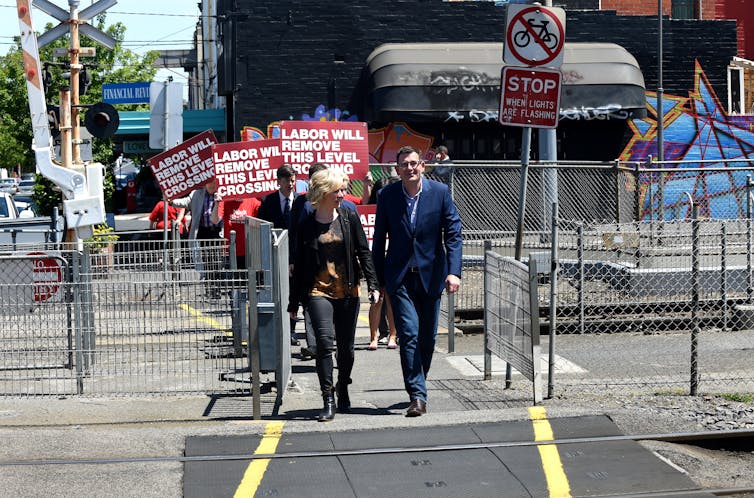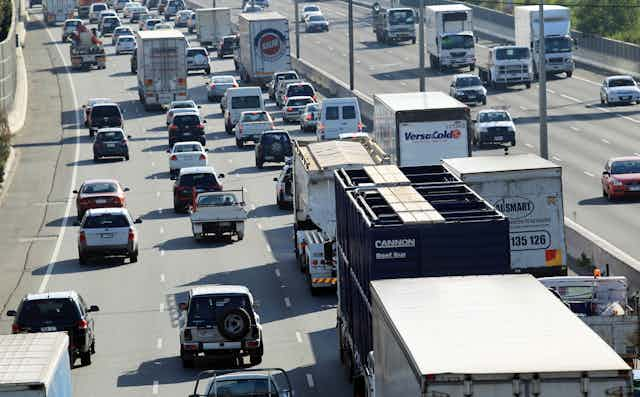Australian cities are inherently diverse places, but that diversity can lead to conflict between different values about what cities should and can be. Our series, Conflict in the City, brings together urban researchers to examine some of these tensions and consider how cities are governed and for whom.
There has been no shortage of ideas about how to spend the A$9.7 billion the Victorian government will receive from selling a 50-year lease for the Port of Melbourne. While Premier Daniel Andrews lamented the Melbourne Metro rail project is already fully funded, the government was quick to announce its program of level-crossing removals would be fast-tracked.
Victoria’s major media outlets have also used this announcement to push for their favourite projects to be funded. These include a rail line to the airport, a second rail tunnel beneath the city, a new tollway in the northeastern suburbs, and even a revival of the zombie East West Link, which was dumped after the last state election.
No doubt, the proceeds from the port lease signal an exciting and productive period of transport infrastructure construction for the state. This is particularly so with Infrastructure Victoria’s 30-year Infrastructure Strategy due out by the end of the year. The release of the draft strategy for public comment until the end of October has further fuelled the debate over competing projects.
However, this strategy is not, and was never intended to be, an integrated land use and transport strategy. Instead it lists a pipeline of projects to meet Victoria’s short-, medium- and long-term infrastructure needs and priorities. It also calls for a congestion tax to ease the pressure on roads.
Infrastructure Victoria will provide guidance to governments, which must then determine what projects are of greatest “need”.
It is still not clear how this strategy will complement and be used in conjunction with the metropolitan strategy Plan Melbourne, which is being “refreshed”. There is no evidence that public consultations to support the development of these two plans have intersected.
Building without a plan?
Melbourne has had 11 metropolitan strategic land use plans since 1954, but has really only ever had one transport plan. The core elements of the 1969 Melbourne Transportation Plan have dominated and driven transport planning ever since.
The 1969 plan included a network of more than 500 kilometres of freeways, new and upgraded arterial roads, the City Loop rail system, new rail lines to Doncaster, Rowville and between Frankston and Dandenong, and 80 level-crossing removals.
The total budget was equivalent to about $30 billion in today’s money. Of this, 86% was devoted to roads – and three-quarters of that was earmarked for freeways.
The plan reflected the thinking of the time globally: cars had come to dominate planning ideology. Few of the rail projects – apart from the City Loop – were realised, while most of the freeways have been built and expanded numerous times. Even the Andrews government’s signature level-crossing removal project is 30 crossings short of the 1969 plan, leaving more than 100 still in place.
Much of the world has moved on since then. Most enlightened governments have realised the focus on private cars at the expense of active and public transport is not viable.
However, the car-based logic of Melbourne’s 1969 plan has been deeply implanted into Victorians’ collective consciousness. The Infrastructure Victoria citizen jury report showed interest in the “completion of existing roads and the existing freeway network”.
It is problematic to not think critically about what “completing the network” means when it is conceived only for private cars. It has long been known that building more and bigger roads cannot solve the congestion problems created by relying on cars to move people around.
It is a problem of spatial efficiency where cars cannot compete. All other modes of transport use space more efficiently and can be extended and upgraded to move millions more people without destroying the city.
The lack of a new strategic transport plan means there is a lack of coherent guidance on how Victoria might tackle its mobility challenges. The need is especially pressing in light of the contemporary environmental and social challenges of climate change and rising social inequality.
Without a new plan, there is no clarity about the values that should frame transport investments and priorities. Infrastructure Australia and Infrastructure Victoria must resort to evaluating “worthy projects” on a case-by-case basis of costs and benefits.
What’s missing is a transparent, coherent and rigorous framework that integrates future transport and land use to meet 21st-century goals of sustainability and social equity.
In the absence of a new plan, politicians focus on the election cycle to win a mandate for projects. The projects that win these “popularity contests” cannot be subjected to rigorous analysis until after the fact.

Today’s priorities for a transport plan
What would a contemporary transport plan need to do?
It would first acknowledge the importance of network connectivity to make the shift to the sustainable modes the 21st-century Australian city demands.
Road networks are the most well-connected and continuous surfaces in our cities, which is why most travel is by private car. To induce significant shifts to active and public transport, any new plan must recognise the massive deficits in networks for cyclists, pedestrians and public transport users, then seek to rectify the gaps.
Such a plan would highlight the network of networks necessary to meet these goals. It would tackle questions of sequencing, design, funding and financing options, and prioritisation of infrastructure needs. Who wins and who loses from a range of scenarios would form part of the process of planning.
These scenarios would allow fundamental questions to be raised. For example, with the creeping privatisation of roads and shifts to tolling instead of taxation, should everyday commuters be forced to subsidise transport projects for road freight corporations? Or should there be viable public transport alternatives?
Surely our transport markets should be competitive for the average user, rather than a monopoly that makes ever-larger numbers of Australians highly vulnerable.
For at least two decades, voters have called for better public transport. Australian cities need a new kind of plan. We need a plan that can survive the vicissitudes of electoral fortune and profit motives to secure an equitable and sustainable future.
Crystal Legacy is hosting a free screening of the 2011 Melbourne International Film Festival favourite, The Triangle Wars, from 5-7pm on October 20 at RMIT University. The event will include a discussion of the larger themes around citizen activism, grassroots campaigning and the contest of ideas in urban planning. See here for details and to register.
You can read other Conflict in the City articles here.

